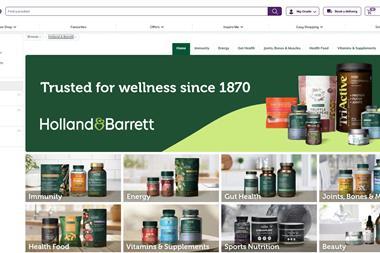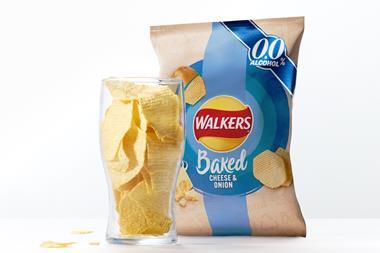As more businesses go into administration, the importance of contingency planning has shot up the agenda for the industry, reports David Burrows
Asda couldn’t have timed it better. It kicked off a trial to source CDs and DVDs directly from suppliers on the very day – 27 November – that Woolworths and its entertainment distribution arm, EUK, went into administration.
EUK, of course, also supplied Asda, which promptly upgraded its trial to a full roll out. Asda boss Andy Bond freely admits: “It was a coincidence we started our trial the same day Woolworths went into administration.”
But this belies the fact Asda had been working on its contingency plan since the full extent of Woolworths’ and EUK’s problems had started to become clear at the tail end of September. When the businesses went into administration, Asda was able to quickly secure its supply chain – unlike a number of other retailers, notably Zavvi. Even though it was prepared, Asda had “learned a lesson” from the EUK incident, says Bond – that you shouldn’t wait to be forewarned to get forearmed.
Whether you’re a small specialist supplier or a large multiple retailer, a sound contingency plan is more important than ever in the current economic climate.
The number of food and drinks companies going into voluntary liquidation has more than doubled over the past year, according to Government figures. Yet, all too often, companies focus on their own worries and fail to consider how business failure along their supply chain could impact on them, according to a survey by the Chartered Institute of Purchasing and Supply. The CIPS survey found that one in five respondents had no knowledge of a supply chain risk review ever having been undertaken within their organisation.
“Many see it as an overhead that simply distracts them from doing their job,” says Andy Cuerel, specialist at risk management company Razor. “Yes, there should be more emphasis on contingency planning, but those worried that it’ll end up being a 10,000-page manual costing thousands of pounds shouldn’t – that’s nonsense.”
The issue of the moment
Of course, it's to be expected that major retailers, Asda included, will have sophisticated plans in place should their supply chains fail. In the current climate, however, these same retailers concede that contingency planning has risen to rank alongside price as 'the' issue. "A couple of years ago, 95% of my time would have been taken up with selling, but over the past six months it's been 60% selling goods and 40% risk mapping," admits Bond.
Sainsbury's seems equally focused. "The business continuity team is a bit busy at the moment," says a spokesman frankly .
It's an understandable concern. A number of suppliers have experienced difficulties in recent times, Bakkavör's problems being a case in point. A number of retailers have already made contingency plans should the ready meals specialist - saddled with £880m worth of debt - be unable to deliver.
With suppliers falling into administration on a seemingly daily basis, retailers need to be able to respond to any potential break in the supply chain. Most holes on shelves aren't that difficult to fill, as other suppliers are often on hand to step in, says Cuerel. The scenarios that are more difficult to manage are those where a supplier's demise impacts the whole store or significant swathes of it.
"If you look at the major multiples with 40,000 product lines, the failure of any one of those lines won't bring the business to its knees, even if it's something iconic like Heinz Tomato Ketchup," he says. "What would be far more critical is if the plastic bag supplier went belly up."
Retailers should stay particularly close to those who supply them exclusively. "Know who your key suppliers are and do a bit of scenario planning," advises Emma Brooks, representation manager at CIPS.
Spreading the risk
Where possible it is also a good idea to have more than one supplier for a particular line or range, especially when it comes to fruit and vegetables, where exclusive deals are commonplace. This goes for staple goods too, which shoppers expect to be able to buy - and may shop elsewhere for if they can't.
Of course, there is a tension between the need to spread the risk by expanding the supplier base and the drive to source more goods from fewer suppliers, keeping prices in check for the consumer. Too many retailers continue to favour short term financial considerations over a long-term sustainable procurement strategy, says Brooks, although she admits their stance is understandable.
This does not bode well for consumer loyalty. It also exposes the retailer to unnecessary risks if there are problems with a supplier. And regardless of whether retailers are guilty of exacerbating those problems or not, the fact of the matter is that over the coming weeks and months more suppliers are going to find themselves in hot water - and the retailers that don't have a plan B in place are going to get caught out.
Having suppliers on the 'subs bench' should now be seen as essential rather than optional. There is evidence that retailers have already been busy sounding out replacement suppliers. "There are a lot of ranges being briefed to different suppliers," confirms one manufacturer.
The earlier the retailer can identify whether a supplier is in trouble, the better (see box). But what's the next step? Ditch that supplier? Not necessarily, says Brooks. "There's an ethical consideration - pulling out could speed up the supplier's demise. It's a reputational risk, given that a large organisation can attract significant adverse publicity. Don't forget, there's often a lot of time already invested in the supplier relationship too. Communication is key."
Preparing for the worst
It's not just retailers who need to make contingency plans, suppliers in turn have to worry about their supply chain - and the same rules apply. Communication certainly played a major role in smoothie maker Innocent's handling of Serious Food Ltd's recent fall into administration. Sunjuice, Serious Food's subsidiary, bottles smoothies for Innocent, and when the administrators were called in, speculation was rife that availability of Innocent smoothies would be hit.
The disaster never materialised, however, thanks to Innocent's forward planning. "We were aware of the situation in advance, and were in discussions with Sunjuice's owner and the administrators to ensure a clear plan was in place to continue supplying us," explains a spokeswoman for Innocent. "In line with best practice we also have a number of alternative supply routes in place."
As well as considering alternative suppliers, manufacturers should plan alternative locations to continue operating should any problems occur on their own sites, suggests Cuerel. "It's theoretically possible for the likes of Premier Foods, with their multi-site operations, to redeploy a degree of production in their other factories. Single-site producers, however, don't have such privilege. Their best bet is to enter a 'buddy' agreement with a competitor whereby they bail each other out for raw materials or basic production or storage facilities until the affected company is back on its feet."
Like retailers, they should also try to spread their risk, says Duncan Swift, joint head of food and agribusiness at advisory firm Grant Thornton. "All too often, manufacturers become too reliant on one customer and the supermarket buyers will abuse that," he points out, citing the example of Northern Foods, which has reduced its dependency on Marks & Spencer over the past few years and last year pulled out of its £45m Italian ready meals contract with the retailer after rejecting proposed new terms.
With supply chains looking more vulnerable than ever, retailers and manufacturers urgently need to rethink their contingency plans to ensure they can continue to do business if one of the links in their chain fails.
And they must regularly review those plans. After all, Defra had contingency plans in place for the foot and mouth outbreak, but they dated back to the 1960s, causing an initially slow response.
Even in the current climate, the vast majority of contingency plans will never be called into action. "Don't forget that in a contingency plan, you are painting a worst-case scenario - you are thinking the unthinkable," says Swift.
But, as the fallout from the economic crisis demonstrates, the unthinkable is already happening.
Asda couldn’t have timed it better. It kicked off a trial to source CDs and DVDs directly from suppliers on the very day – 27 November – that Woolworths and its entertainment distribution arm, EUK, went into administration.
EUK, of course, also supplied Asda, which promptly upgraded its trial to a full roll out. Asda boss Andy Bond freely admits: “It was a coincidence we started our trial the same day Woolworths went into administration.”
But this belies the fact Asda had been working on its contingency plan since the full extent of Woolworths’ and EUK’s problems had started to become clear at the tail end of September. When the businesses went into administration, Asda was able to quickly secure its supply chain – unlike a number of other retailers, notably Zavvi. Even though it was prepared, Asda had “learned a lesson” from the EUK incident, says Bond – that you shouldn’t wait to be forewarned to get forearmed.
Whether you’re a small specialist supplier or a large multiple retailer, a sound contingency plan is more important than ever in the current economic climate.
The number of food and drinks companies going into voluntary liquidation has more than doubled over the past year, according to Government figures. Yet, all too often, companies focus on their own worries and fail to consider how business failure along their supply chain could impact on them, according to a survey by the Chartered Institute of Purchasing and Supply. The CIPS survey found that one in five respondents had no knowledge of a supply chain risk review ever having been undertaken within their organisation.
“Many see it as an overhead that simply distracts them from doing their job,” says Andy Cuerel, specialist at risk management company Razor. “Yes, there should be more emphasis on contingency planning, but those worried that it’ll end up being a 10,000-page manual costing thousands of pounds shouldn’t – that’s nonsense.”
The issue of the moment
Of course, it's to be expected that major retailers, Asda included, will have sophisticated plans in place should their supply chains fail. In the current climate, however, these same retailers concede that contingency planning has risen to rank alongside price as 'the' issue. "A couple of years ago, 95% of my time would have been taken up with selling, but over the past six months it's been 60% selling goods and 40% risk mapping," admits Bond.
Sainsbury's seems equally focused. "The business continuity team is a bit busy at the moment," says a spokesman frankly .
It's an understandable concern. A number of suppliers have experienced difficulties in recent times, Bakkavör's problems being a case in point. A number of retailers have already made contingency plans should the ready meals specialist - saddled with £880m worth of debt - be unable to deliver.
With suppliers falling into administration on a seemingly daily basis, retailers need to be able to respond to any potential break in the supply chain. Most holes on shelves aren't that difficult to fill, as other suppliers are often on hand to step in, says Cuerel. The scenarios that are more difficult to manage are those where a supplier's demise impacts the whole store or significant swathes of it.
"If you look at the major multiples with 40,000 product lines, the failure of any one of those lines won't bring the business to its knees, even if it's something iconic like Heinz Tomato Ketchup," he says. "What would be far more critical is if the plastic bag supplier went belly up."
Retailers should stay particularly close to those who supply them exclusively. "Know who your key suppliers are and do a bit of scenario planning," advises Emma Brooks, representation manager at CIPS.
Spreading the risk
Where possible it is also a good idea to have more than one supplier for a particular line or range, especially when it comes to fruit and vegetables, where exclusive deals are commonplace. This goes for staple goods too, which shoppers expect to be able to buy - and may shop elsewhere for if they can't.
Of course, there is a tension between the need to spread the risk by expanding the supplier base and the drive to source more goods from fewer suppliers, keeping prices in check for the consumer. Too many retailers continue to favour short term financial considerations over a long-term sustainable procurement strategy, says Brooks, although she admits their stance is understandable.
This does not bode well for consumer loyalty. It also exposes the retailer to unnecessary risks if there are problems with a supplier. And regardless of whether retailers are guilty of exacerbating those problems or not, the fact of the matter is that over the coming weeks and months more suppliers are going to find themselves in hot water - and the retailers that don't have a plan B in place are going to get caught out.
Having suppliers on the 'subs bench' should now be seen as essential rather than optional. There is evidence that retailers have already been busy sounding out replacement suppliers. "There are a lot of ranges being briefed to different suppliers," confirms one manufacturer.
The earlier the retailer can identify whether a supplier is in trouble, the better (see box). But what's the next step? Ditch that supplier? Not necessarily, says Brooks. "There's an ethical consideration - pulling out could speed up the supplier's demise. It's a reputational risk, given that a large organisation can attract significant adverse publicity. Don't forget, there's often a lot of time already invested in the supplier relationship too. Communication is key."
Preparing for the worst
It's not just retailers who need to make contingency plans, suppliers in turn have to worry about their supply chain - and the same rules apply. Communication certainly played a major role in smoothie maker Innocent's handling of Serious Food Ltd's recent fall into administration. Sunjuice, Serious Food's subsidiary, bottles smoothies for Innocent, and when the administrators were called in, speculation was rife that availability of Innocent smoothies would be hit.
The disaster never materialised, however, thanks to Innocent's forward planning. "We were aware of the situation in advance, and were in discussions with Sunjuice's owner and the administrators to ensure a clear plan was in place to continue supplying us," explains a spokeswoman for Innocent. "In line with best practice we also have a number of alternative supply routes in place."
As well as considering alternative suppliers, manufacturers should plan alternative locations to continue operating should any problems occur on their own sites, suggests Cuerel. "It's theoretically possible for the likes of Premier Foods, with their multi-site operations, to redeploy a degree of production in their other factories. Single-site producers, however, don't have such privilege. Their best bet is to enter a 'buddy' agreement with a competitor whereby they bail each other out for raw materials or basic production or storage facilities until the affected company is back on its feet."
Like retailers, they should also try to spread their risk, says Duncan Swift, joint head of food and agribusiness at advisory firm Grant Thornton. "All too often, manufacturers become too reliant on one customer and the supermarket buyers will abuse that," he points out, citing the example of Northern Foods, which has reduced its dependency on Marks & Spencer over the past few years and last year pulled out of its £45m Italian ready meals contract with the retailer after rejecting proposed new terms.
With supply chains looking more vulnerable than ever, retailers and manufacturers urgently need to rethink their contingency plans to ensure they can continue to do business if one of the links in their chain fails.
And they must regularly review those plans. After all, Defra had contingency plans in place for the foot and mouth outbreak, but they dated back to the 1960s, causing an initially slow response.
Even in the current climate, the vast majority of contingency plans will never be called into action. "Don't forget that in a contingency plan, you are painting a worst-case scenario - you are thinking the unthinkable," says Swift.
But, as the fallout from the economic crisis demonstrates, the unthinkable is already happening.
Spotting who's in trouble
With the economy and markets changing so quickly, retailers and manufacturers need to keep a close eye on those they do business with. Regular site visits are vital, and here are some tell-tale signs that might warrant investigation:
- a reduction in staff;
- a change to working patterns. For example, if a manufacturer moves from a three-shift system to a two-shift one;
- work only being carried out for a small number of customers;
- a sale of assets such as premises or equipment may point to a business contraction;
- a lack of investment in the business: they are possibly increasingly reliant on old technology and working practices (though not many will be investing heavily in the current climate);
- staff are more reticent when answering questions
Companies should also be looking out for other adverse indicators within business credit reports, such as: late filing of annual returns and financial accounts, and the incidence and number of County Court Judgements against a business, says Emma Brooks representation manager at CIPS.
“Our statistical analysis shows that businesses with poor trading results tend to delay submitting their accounts as long as possible, hence late filing of accounts is often a sign of bad news to come.”
With the economy and markets changing so quickly, retailers and manufacturers need to keep a close eye on those they do business with. Regular site visits are vital, and here are some tell-tale signs that might warrant investigation:
- a reduction in staff;
- a change to working patterns. For example, if a manufacturer moves from a three-shift system to a two-shift one;
- work only being carried out for a small number of customers;
- a sale of assets such as premises or equipment may point to a business contraction;
- a lack of investment in the business: they are possibly increasingly reliant on old technology and working practices (though not many will be investing heavily in the current climate);
- staff are more reticent when answering questions
Companies should also be looking out for other adverse indicators within business credit reports, such as: late filing of annual returns and financial accounts, and the incidence and number of County Court Judgements against a business, says Emma Brooks representation manager at CIPS.
“Our statistical analysis shows that businesses with poor trading results tend to delay submitting their accounts as long as possible, hence late filing of accounts is often a sign of bad news to come.”
Secrets to successful planning
Contingency plans will vary from company to company and from potential risk to potential risk. However, there are some basic rules, and these apply to both the buyer’s own organisation and suppliers.
Ensure that each tier of the supply chain has its own contingency plan.
Ensure that your contingency plan is regularly reviewed and updated as risks and vulnerabilities change.
Group your contingency plans into two types – those that have a high probability of occurring and those that have a high impact on company performance.
The plan should clearly state what the key activities are and the options – alternative suppliers, alternative places of operation etc.
Do some scenario planning: what happens if... ?
The plan should make clear who is responsible for what activity in the event of an ‘incident’ occurring.
Think about geography –are all your suppliers in an animal disease hotspot?
Ensure that your staff understand the contingency plan and are able to carry it out.
Plans should include measures on how to communicate problems, both internally and externally.
Contingency plans will vary from company to company and from potential risk to potential risk. However, there are some basic rules, and these apply to both the buyer’s own organisation and suppliers.
Ensure that each tier of the supply chain has its own contingency plan.
Ensure that your contingency plan is regularly reviewed and updated as risks and vulnerabilities change.
Group your contingency plans into two types – those that have a high probability of occurring and those that have a high impact on company performance.
The plan should clearly state what the key activities are and the options – alternative suppliers, alternative places of operation etc.
Do some scenario planning: what happens if... ?
The plan should make clear who is responsible for what activity in the event of an ‘incident’ occurring.
Think about geography –are all your suppliers in an animal disease hotspot?
Ensure that your staff understand the contingency plan and are able to carry it out.
Plans should include measures on how to communicate problems, both internally and externally.













No comments yet